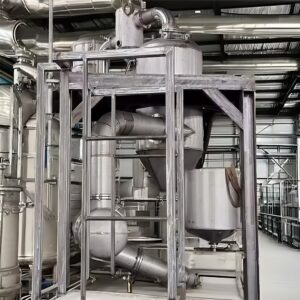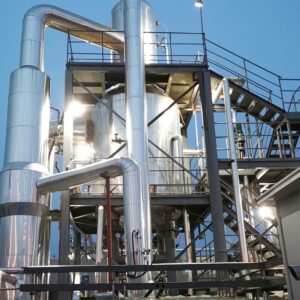1. Introduction to MVR Evaporators:
The MVR (Mechanical Vapor Recompression) device compresses the secondary steam generated within the evaporation system using a compressor to increase its thermal enthalpy. This steam is then recycled for heating and evaporation, maximizing the use of secondary steam and condensate’s residual heat, resulting in significant energy savings. The system does not require fresh steam, saving over 90% of condensate, 80% of manpower, and 60% of space. MVR evaporators use compressors to compress secondary steam. Domestic compressors can provide a temperature rise of 20°C each, while imported compressors can provide a temperature rise of 9°C each. Thus, the system requires the feed water’s boiling point to be as much as 15°C lower as possible to achieve energy-saving evaporation. In single-effect evaporation, the fresh steam is used only once within the system. The key difference between MVR and multi-effect evaporators is that the secondary steam is continuously recycled within the system, thus preventing energy waste. The system’s energy consumption involves raising the temperature from 119°C to 130°C, which is the energy consumed by the compressor. The energy-saving aspect of MVR is evident as it only requires 16 KJ (per ton of water) to convert secondary steam from useless to useful.
2. Advantages of MVR Evaporators:
High Heat Transfer Coefficient: This type of evaporator features a variable flow field that easily brings the feed liquid to a vigorous turbulent state, resulting in a heat transfer coefficient that is 2-3 times higher than that of tube-type evaporators.
Less Prone to Blockage: The feed liquid forms a disturbing flow on the heat exchange surface, which can scour the surface and remove adhered scale deposits, extending the scaling period.
Very Smooth Surface: The manufacturing process ensures that the surface roughness of the heat exchange surface is controlled to a very low value, making it difficult for contaminants to adhere. The scaling rate of this type of heat exchanger is only 1/5 that of tube-type heat exchangers.
Easy to Clean and Maintain: The plate structure allows for easy disassembly of the heat exchange surface, and any contaminated or damaged surface can be easily replaced.
Applicable to: Evaporation and crystallization of various inorganic salts, evaporation of feed liquids with high hardness, concentration of landfill leachate, concentration of feed liquids in the food, fermentation, and pharmaceutical industries, and concentration of heat-sensitive materials.
3. Components of MVR Evaporators:
Preheater: In most cases, the solution to be evaporated needs to be preheated before entering the evaporator.
Evaporator: The solution to be evaporated is heated with steam in the evaporator to produce evaporation. Different types of evaporators are selected based on the properties of the solution.
Separator: Used for the separation of steam and liquid. Different separators can be chosen based on the properties of the solution, such as centrifugal separators, gravity separators, or separators with special structures.
Various Pumps: Transport the solution to be evaporated and the concentrated solution. Different types of pumps, such as centrifugal pumps, positive displacement pumps, and screw pumps, can be selected based on the properties of the solution.
Compressor: Provides the heat source for evaporation by compressing the secondary steam and increasing its thermal enthalpy. Various compressors can be selected based on different flow rates and compression ratio requirements. For situations requiring higher pressure increases, multi-stage compressors can be used in series.
Control System: The control center of the MVR evaporation system adjusts motor speeds, controls valves, flow meters, temperature, and pressure to achieve automatic evaporation, cleaning, shutdown operations, and to maintain system balance through automatic alarms and protection systems.
Cleaning System: After a period of evaporation, scaling may occur. Over 99% of scaling can be removed by adding chemical solvents. CIP (cleaning-in-place) or disassembly cleaning can be used.







Reviews
There are no reviews yet.